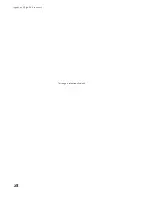
15
139467_03 GF 370 DV II June 2015
Figure 19. Gas supply valve types and fittings.
Soap Solution Leak Test
• Mix a 50-50 solution of water and dish soap.
• Light appliance - see lighting instructions on the
back cover of this manual or on the rating plate.
• Brush or spray all joints and connections with the
soapy water solution.
• If bubbles appear at any connection or seam or a
gas odor is detected, immediately turn gas control
knob to the OFF position.
Tighten or reconnect the leaking joint and retest
for any gas leaks.
The line must be disconnected from the gas
supply line by closing the main supply manual gas
shut-off valve (gas cock) during any pressure testing
of the gas supply piping system that is equal to or
exceeds pressures of 1/2 psig (3.5 kPa).
4. Testing Gas Pressure
Proper gas pressure provides a consistent flow of gas
to the appliance and is instrumental in checking for
gas leaks. There are two pressure test points on the
front of the stove control valve where test gauge con-
nections are made. See Fig. 20. Gauge connections
are identified by:
• E for inlet or supply pressure ( the amount of gas
coming to the valve.)
• A for manifold pressure (the amount of gas that is
coming out of the valve to the burner.)
WARNING
DO NOT ALLOW THE INLET GAS PRESSURE TO
EXCEED
14.0
” WC (OR 1/2 PSIG) AS SERIOUS
DAMAGE TO THE VALVE MAY RESULT.
NEVER USE AN OPEN FLAME TO CHECK FOR GAS
LEAKS.
ALWAYS REFER TO THE LIGHTING INSTRUCTIONS
ON THE INSIDE BACK COVER OF THIS MANUAL
WHEN LIGHTING THE STOVE.
Figure 20. Pressure test points located on the front
of the valve.
Manifold
Inlet
Pilot Adjustment
E
A
Inlet Pressure
MIN MAX
Natural Gas: 5.0 WC (1.24 kPa) 7.0 WC (1.74 kPa)
Propane: 12.0 WC (2.99 kPa) 14.0 WC (3.48 kPa)
Manifold Pressure
MIN MAX
Natural Gas: 1.6 WC (0.398 kPa) 3.5 WC (.87 kPa)
Propane: 6.4 WC (1.59 kPa) 10.0 WC (2.48 kPa)
ALWAYS TEST PRESSURES WITH VALVE REGULATOR
CONTROL AT THE HIGHEST SETTING.
Symptoms of incorrect gas pressure include:
Insufficient gas pressure:
• Small pilot flame which can result in insufficient
millivolts.
• Little variation in flame picture between HI and LO
regulator settings.
• Insufficient gas to support more than one appli-
ance causing nuisance outages or gas surges.
Excessive gas pressure:
• Permanent damage to valve causing complete ap-
pliance shut down.
• Too large a pilot flame resulting in overheating of
the power generator and consequent shut down.
• Sooting due to impingement and/or incorrect fuel
to air mix.
















































